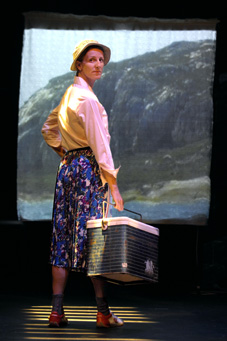 |
Cheryl Wheatley, Queen of the Snakepit photo Michael Rayner |
All the props in this performance emerge from Lois’s Esky, and many of them end up in a strange shrine-like arrangement carefully constructed over the duration of the show. Containing fragments from the stories told, such as Naked Lady flowers, abalone shells, paper nautilus shells, the pieces of a ripped-up crayfishing licence and a windswept tree branch, this assemblage is like a tribute to Flinders Island. Throughout we’re shown a teatowel map and hazy landscape images, but it is this collection that makes Flinders visible for the audience.
In Flinders folklore the paper nautilus shell washes up every seven years. This periodic appearance is symbolic of the islander way of life, characterised by a gradual passing of time that is measured on the ancient scale of the landscape itself. The return of the shell also mirrors the journey of the island’s youth who leave seeking adventure and return home (the place, as Lois found, where your feet grow roots) years later. Coming to shore from the ocean, the shell also links the domains of the men and women folk. We learn that while the fishermen are free of the island when they are at sea, the women are relentlessly land-bound.
Queen of the Snakepit is the story of female life on Flinders told through four characters from the one family. In addition to Lois there’s her cantankerous mother Queenie who single-handedly built a jetty of stones for her fishermen husband and sons to come home to, but now spends her days alone. There’s eccentric aunt Myrtle who, when her complaints to Parks and Wildlife back in the early 1990s were ignored, took the feral cat problem into her own hands. And there’s the memory of young Lily staring out the window asking questions and making observations about this place and its people. She at first seems to be Queenie’s dead daughter, but is later revealed to be Lois herself.
This performance is devised and performed by Cheryl Wheatley. She undergoes impressive physical transformations as she morphs between four women of different generations to create a montage of incidents and memories across time and space. Moments of humour and intimacy created by each character propel the performance. Queenie’s debate with herself about whether or not the old pine tree needs its middle cut out was for me a very tender insight into a life of hardship and isolation. We learn from the dedication at the end that the character of Queenie is actually based on Cheryl’s mother, who passed away only weeks before this show opened.
In contrast to these engaging characters our guide and narrator Lois seems a conglomeration of loud ocker stereotypes—from her op-shop ensemble to her clipped language, hackneyed expressions and tit jokes. Sure, Lois is meant to be a woman of strong personality, the tough-as-guts country type who’s lived most her life in a small male-dominated community. I know this kind of sheila, I’ve got one or two in my own family, but I find Lois an ugly caricature. I see none of the knowingness, the disarming charm or dangerously sharp wit that makes natural yarn spinners of the Australian breed so charismatic. Given Cheryl is a fourth generation Flinders Islander I wonder why she felt the need to invent the ‘larger than life’ Lois.
It is only as Lois that Wheatley initiates audience interaction, and her manner is rather like playground bullying. She plays favourites with some individuals with whom she holds inaudible, rather lengthy, one-on-one conversations mid-performance. In other moments she intentionally invades personal space, helping herself to our drinks, blasting us with a wind machine and spraying us with water. I think I experienced a personality clash with Lois. I suspect, at its root, this may reflect a discomfort I feel with much such theatre. But that aside, I simply didn’t find this “witty and wise” character insightful or funny.
There is beauty, richness, idiosyncrasy and universality in the stories of Queen of the Snakepit. The family connections between characters give this account of place its form and sense of authenticity. Unfortunately however, the crude rendering of the central character meant that intimate and engaging moments were scattered through an often tedious and frustrating show. Curiously, I like the fact that after this ‘tour’ I still have very little sense of what Flinders Island would be like to visit.
is theatre, Queen of the Snakepit, deviser/performer Cheryl Wheatley, co-director/dramaturg Robin Laurie, writer Finegan Kruckemeyer, co-director Tania Bosak, designer Greg Methé, executive producer Ryk Goddard; The Backspace Theatre, Hobart, Ten Days on the Island, March 29-3
© Bec Tudor; for permission to reproduce apply to [email protected]








 back
back